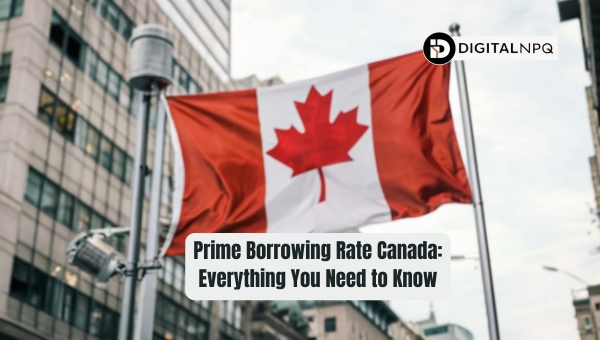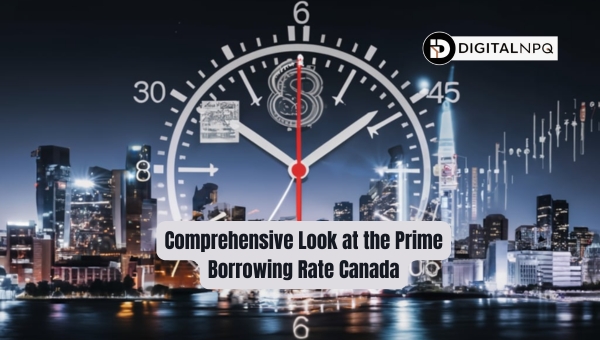Prime Borrowing Rate Canada: Transform Your Loan Strategy

Anyone dealing with loans, mortgages, and credit must be aware of Prime Borrowing Rate Canada. This article will examine the prime rate’s historical evolution, current state, and effects on borrowing.
We will also look at past trends and projections for the future, as well as the connection between the prime rate and the overnight rate set by the Bank of Canada.
You’ll have a thorough understanding of how the prime rate impacts your money by the conclusion, which will improve your ability to make financial decisions. Let’s explore and learn more about the nuances of Canada’s prime borrowing rate.
Comprehensive Look at the Prime Borrowing Rate Canada
The prime borrowing rate in Canada is a key interest rate set by major financial institutions. It is mainly influenced by the Bank of Canada’s overnight rate. This rate serves as a baseline for variable interest rates on loans, such as mortgages and lines of credit. As of August 21, 2024, the prime rate in Canada stands at 6.7%.

This rate is subject to change based on economic conditions, inflation, and policies set by the central bank. Understanding the prime borrowing rate is crucial for both consumers and businesses, as it directly impacts borrowing costs. Financial stability, economic growth, and consumer spending all play significant roles in determining the prime rate.
How the Prime Rate is Set?
The prime rate in Canada is determined by major banks and serves as a benchmark for various types of loans. It is heavily influenced by the Bank of Canada’s overnight rate, which is the rate at which banks lend money to each other. Understanding this relationship is key to grasping how the prime rate is established and adjusted.

Relationship with the Bank of Canada Overnight Rate
The prime rate is closely linked to the Bank of Canada’s overnight rate. When the overnight rate changes, it directly affects the borrowing costs for banks, which in turn adjust their prime rates.
Key points include:
- Increase in overnight rate leads to higher prime rates.
- Decrease in overnight rate results in lower prime rates.
- Banks use this rate to determine the cost of borrowing for consumers.
Factors Influencing the Prime Rate
Several economic elements can impact the prime rate. These factors include:
- Inflation Rates: Higher inflation often leads to higher prime rates.
- Economic Growth: Strong economic growth can result in increased prime rates.
- Employment Levels: Higher employment rates can push the prime rate up.
- Global Economic Conditions: International financial stability influences the prime rate.
- Consumer Spending: Changes in consumer spending patterns can affect the rate.
By understanding these aspects, one can better navigate the dynamics of the prime borrowing rate in Canada.
Also Read: EITC Refund Date 2024: Maximize Your Tax Refund
Current Prime Rate in Canada
The prime borrowing rate in Canada is a critical interest rate used by banks to set rates for various loans and lines of credit. It is influenced by economic conditions and policies set by the Bank of Canada. This rate plays a significant role in determining borrowing costs for both consumers and businesses.

Latest Updates and Trends
Recent changes to the prime rate in Canada reflect the country’s ongoing economic adjustments:
- Current Rate: As of August 21, 2024, the prime rate is 6.7%.
- Recent Trends: There has been a slight decrease from previous months, influenced by efforts to control inflation.
- Future Predictions: Experts expect minor adjustments based on economic indicators like inflation and employment rates.
Canada’s Prime Rate Variations, 2010–2024
Here is the table formatted based on the data you provided:
| Effective Date | Prime Rate | Change |
|---|---|---|
| July 24, 2024 | 6.70% | -0.25% |
| June 5, 2024 | 6.95% | -0.25% |
| July 12, 2023 | 7.20% | 0.25% |
| June 8, 2023 | 6.95% | 0.25% |
| January 25, 2023 | 6.70% | 0.25% |
| December 8, 2022 | 6.45% | 0.50% |
| October 27, 2022 | 5.95% | 0.50% |
The Bank of Canada’s (BoC) policy interest rate—also referred to as the BoC’s target overnight rate—has the biggest impact on the prime rate. These rates are closely connected, even though they are not the same. Lenders often modify prime rates in a matter of days following a change by the Bank of Canada in the target overnight rate.
Historical Prime Rate Overview
Looking back at the history of the prime rate in Canada reveals notable fluctuations:
- 1980s Peak: The rate reached a high of 22.75% during the early 1980s economic crisis.
- Stabilization: In recent decades, the rate has generally stabilized, averaging around 2% above the Bank of Canada’s overnight rate.
- COVID-19 Impact: The rate dropped significantly during the COVID-19 pandemic to support economic recovery.
Impact of the Prime Rate on Borrowing
The prime borrowing rate in Canada significantly influences various types of loans and credit products. Understanding how these changes impact borrowing costs can help consumers make informed financial decisions.
Credit Cards
Changes in the prime borrowing rate directly affect the interest rates on credit cards. Here’s how it works:
- Interest Rate Adjustments: When the prime rate increases, credit card interest rates typically rise as well. This means that consumers carrying a balance on their credit cards will face higher interest charges.
- Cost of Borrowing: Higher interest rates make it more expensive to carry a balance, which can lead to increased monthly payments and overall debt.
- Variable Interest Rates: Many credit cards offer variable interest rates tied to the prime rate. As the prime rate fluctuates, so does the interest rate on these cards, impacting consumers’ borrowing costs.
Variable-Rate Mortgages
For homeowners with variable-rate mortgages, the prime rate plays a crucial role in determining monthly mortgage payments. Here’s a closer look:
- Payment Fluctuations: When the prime rate rises, the interest rate on variable-rate mortgages also increases. This directly leads to higher monthly mortgage payments.
- Cost of Homeownership: Increased mortgage payments can strain a household budget, affecting financial stability.
- Potential Savings: Conversely, when the prime rate decreases, homeowners with variable-rate mortgages benefit from lower interest rates, resulting in reduced monthly payments and potential savings over the life of the loan.
Lines of Credit
Lines of credit are another area where movements in the prime borrowing rate have a noticeable impact. Here’s how:
- Interest Rate Changes: Interest rates on lines of credit are often tied to the prime rate. An increase in the prime rate results in higher interest costs for consumers using these credit lines.
- Borrowing Costs: As the cost of borrowing rises, it becomes more expensive to use a line of credit for expenses, whether for personal or business purposes.
- Debt Management: Consumers need to monitor changes in the prime rate to manage their debt effectively, as fluctuations can affect the overall cost of borrowing through lines of credit.
Car and Auto Loans
The prime borrowing rate also affects car and auto loan interest rates, impacting the affordability of vehicle financing. Here’s what you need to know:
- Loan Interest Rates: When the prime rate increases, auto loan interest rates tend to rise. This means higher monthly payments for new car loans.
- Financing Costs: Higher interest rates can make financing a vehicle more expensive, affecting the total cost of ownership.
- Budget Considerations: Consumers should consider the prime rate when planning to finance a vehicle, as changes in the rate can influence loan affordability and overall financial planning.
Also Read: Time Change Spring 2024: Everything You Need to Know
Prime Rate Forecast
Predicting changes in Canada’s prime borrowing rate involves analyzing both short-term and long-term economic trends. Experts provide insights into what borrowers can expect in the near future and over the coming years. Let’s dive into some predictions and the economic indicators to watch.
Short-term and Long-term Predictions
Experts suggest that in the short term, Canada’s prime borrowing rate might decrease if inflation continues to stabilize. This could mean lower borrowing costs for consumers and businesses.
In the long term, the prime rate is expected to stabilize around a moderate level, depending on the overall economic recovery and growth trends. These predictions help borrowers plan their finances more effectively.
Economic Indicators to Watch
Several economic indicators can hint at future changes in the prime borrowing rate:
- Inflation Rates: High inflation often leads to higher interest rates.
- Employment Statistics: Job growth or decline can influence rate adjustments.
- Consumer Spending: Increased spending can push rates higher to control inflation.
- Global Economic Conditions: International trade and economic health impact domestic rates.
By monitoring these indicators, borrowers can stay informed about potential rate changes.
FAQs
What is the TD prime rate today?
The TD prime rate today is 6.7%. This rate is set by TD Bank and is influenced by the Bank of Canada’s overnight rate.
What is the Fed prime rate today?
The Fed prime rate today stands at 8.5%. This rate is determined by major U.S. banks and is influenced by the Federal Reserve’s policies.
What is the current prime lending rate in Canada?
The current prime lending rate in Canada is 6.7%. It is set by major Canadian banks and reflects economic conditions and central bank policies.
Conclusion
Understanding the prime borrowing rate in Canada is essential for anyone navigating the financial landscape. This rate affects everything from mortgage payments to credit card interest rates. By staying informed about how this rate is set, current trends, and its impact on various financial products, you can make better borrowing decisions.
It’s crucial to monitor economic indicators and expert forecasts to anticipate changes in the prime rate. In summary, being knowledgeable about the prime borrowing rate empowers you to manage your finances more effectively. For more insights and updates on financial topics, make sure to explore other informative blogs on our site!
